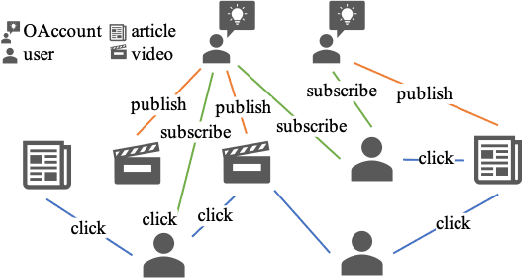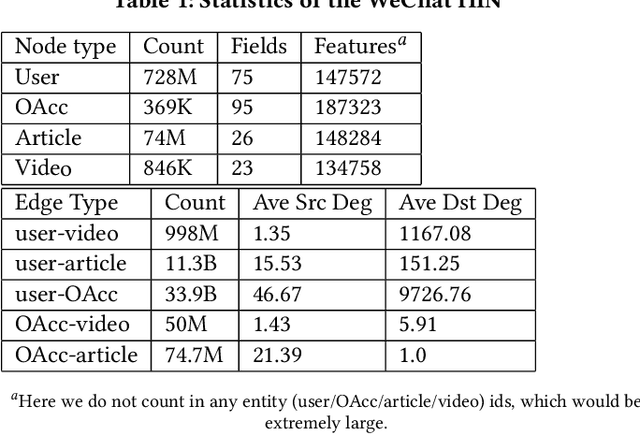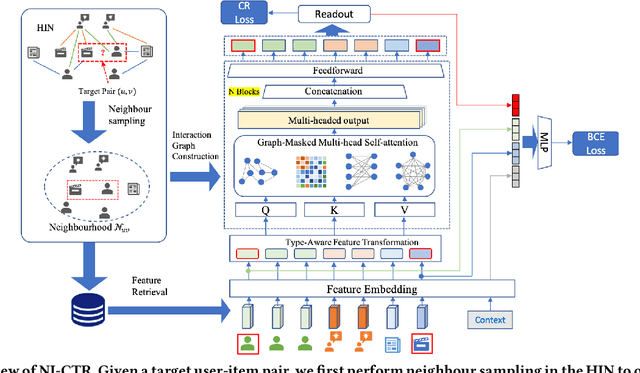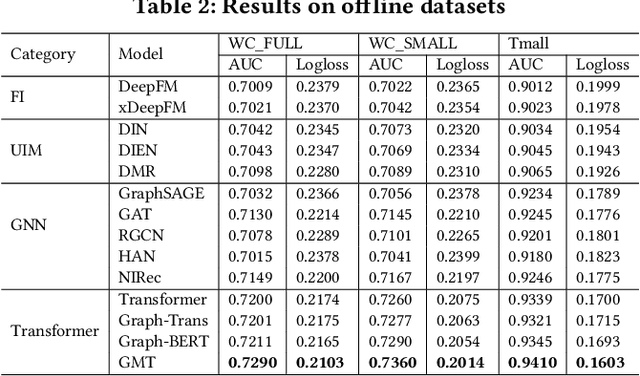Da Luo
RecGPT: A Foundation Model for Sequential Recommendation
Jun 06, 2025Abstract:This work addresses a fundamental barrier in recommender systems: the inability to generalize across domains without extensive retraining. Traditional ID-based approaches fail entirely in cold-start and cross-domain scenarios where new users or items lack sufficient interaction history. Inspired by foundation models' cross-domain success, we develop a foundation model for sequential recommendation that achieves genuine zero-shot generalization capabilities. Our approach fundamentally departs from existing ID-based methods by deriving item representations exclusively from textual features. This enables immediate embedding of any new item without model retraining. We introduce unified item tokenization with Finite Scalar Quantization that transforms heterogeneous textual descriptions into standardized discrete tokens. This eliminates domain barriers that plague existing systems. Additionally, the framework features hybrid bidirectional-causal attention that captures both intra-item token coherence and inter-item sequential dependencies. An efficient catalog-aware beam search decoder enables real-time token-to-item mapping. Unlike conventional approaches confined to their training domains, RecGPT naturally bridges diverse recommendation contexts through its domain-invariant tokenization mechanism. Comprehensive evaluations across six datasets and industrial scenarios demonstrate consistent performance advantages.
RecLM: Recommendation Instruction Tuning
Dec 26, 2024



Abstract:Modern recommender systems aim to deeply understand users' complex preferences through their past interactions. While deep collaborative filtering approaches using Graph Neural Networks (GNNs) excel at capturing user-item relationships, their effectiveness is limited when handling sparse data or zero-shot scenarios, primarily due to constraints in ID-based embedding functions. To address these challenges, we propose a model-agnostic recommendation instruction-tuning paradigm that seamlessly integrates large language models with collaborative filtering. Our proposed Recommendation Language Model (RecLM) enhances the capture of user preference diversity through a carefully designed reinforcement learning reward function that facilitates self-augmentation of language models. Comprehensive evaluations demonstrate significant advantages of our approach across various settings, and its plug-and-play compatibility with state-of-the-art recommender systems results in notable performance enhancements.
DiffMM: Multi-Modal Diffusion Model for Recommendation
Jun 17, 2024



Abstract:The rise of online multi-modal sharing platforms like TikTok and YouTube has enabled personalized recommender systems to incorporate multiple modalities (such as visual, textual, and acoustic) into user representations. However, addressing the challenge of data sparsity in these systems remains a key issue. To address this limitation, recent research has introduced self-supervised learning techniques to enhance recommender systems. However, these methods often rely on simplistic random augmentation or intuitive cross-view information, which can introduce irrelevant noise and fail to accurately align the multi-modal context with user-item interaction modeling. To fill this research gap, we propose a novel multi-modal graph diffusion model for recommendation called DiffMM. Our framework integrates a modality-aware graph diffusion model with a cross-modal contrastive learning paradigm to improve modality-aware user representation learning. This integration facilitates better alignment between multi-modal feature information and collaborative relation modeling. Our approach leverages diffusion models' generative capabilities to automatically generate a user-item graph that is aware of different modalities, facilitating the incorporation of useful multi-modal knowledge in modeling user-item interactions. We conduct extensive experiments on three public datasets, consistently demonstrating the superiority of our DiffMM over various competitive baselines. For open-sourced model implementation details, you can access the source codes of our proposed framework at: https://github.com/HKUDS/DiffMM .
Synergistic Anchored Contrastive Pre-training for Few-Shot Relation Extraction
Dec 24, 2023



Abstract:Few-shot Relation Extraction (FSRE) aims to extract relational facts from a sparse set of labeled corpora. Recent studies have shown promising results in FSRE by employing Pre-trained Language Models (PLMs) within the framework of supervised contrastive learning, which considers both instances and label facts. However, how to effectively harness massive instance-label pairs to encompass the learned representation with semantic richness in this learning paradigm is not fully explored. To address this gap, we introduce a novel synergistic anchored contrastive pre-training framework. This framework is motivated by the insight that the diverse viewpoints conveyed through instance-label pairs capture incomplete yet complementary intrinsic textual semantics. Specifically, our framework involves a symmetrical contrastive objective that encompasses both sentence-anchored and label-anchored contrastive losses. By combining these two losses, the model establishes a robust and uniform representation space. This space effectively captures the reciprocal alignment of feature distributions among instances and relational facts, simultaneously enhancing the maximization of mutual information across diverse perspectives within the same relation. Experimental results demonstrate that our framework achieves significant performance enhancements compared to baseline models in downstream FSRE tasks. Furthermore, our approach exhibits superior adaptability to handle the challenges of domain shift and zero-shot relation extraction. Our code is available online at https://github.com/AONE-NLP/FSRE-SaCon.
Graph Pre-training and Prompt Learning for Recommendation
Nov 28, 2023



Abstract:GNN-based recommenders have excelled in modeling intricate user-item interactions through multi-hop message passing. However, existing methods often overlook the dynamic nature of evolving user-item interactions, which impedes the adaption to changing user preferences and distribution shifts in newly arriving data. Thus, their scalability and performances in real-world dynamic environments are limited. In this study, we propose GraphPL, a framework that incorporates parameter-efficient and dynamic graph pre-training with prompt learning. This novel combination empowers GNNs to effectively capture both long-term user preferences and short-term behavior dynamics, enabling the delivery of accurate and timely recommendations. Our GraphPL framework addresses the challenge of evolving user preferences by seamlessly integrating a temporal prompt mechanism and a graph-structural prompt learning mechanism into the pre-trained GNN model. The temporal prompt mechanism encodes time information on user-item interaction, allowing the model to naturally capture temporal context, while the graph-structural prompt learning mechanism enables the transfer of pre-trained knowledge to adapt to behavior dynamics without the need for continuous incremental training. We further bring in a dynamic evaluation setting for recommendation to mimic real-world dynamic scenarios and bridge the offline-online gap to a better level. Our extensive experiments including a large-scale industrial deployment showcases the lightweight plug-in scalability of our GraphPL when integrated with various state-of-the-art recommenders, emphasizing the advantages of GraphPL in terms of effectiveness, robustness and efficiency.
Aspect-oriented Opinion Alignment Network for Aspect-Based Sentiment Classification
Aug 22, 2023Abstract:Aspect-based sentiment classification is a crucial problem in fine-grained sentiment analysis, which aims to predict the sentiment polarity of the given aspect according to its context. Previous works have made remarkable progress in leveraging attention mechanism to extract opinion words for different aspects. However, a persistent challenge is the effective management of semantic mismatches, which stem from attention mechanisms that fall short in adequately aligning opinions words with their corresponding aspect in multi-aspect sentences. To address this issue, we propose a novel Aspect-oriented Opinion Alignment Network (AOAN) to capture the contextual association between opinion words and the corresponding aspect. Specifically, we first introduce a neighboring span enhanced module which highlights various compositions of neighboring words and given aspects. In addition, we design a multi-perspective attention mechanism that align relevant opinion information with respect to the given aspect. Extensive experiments on three benchmark datasets demonstrate that our model achieves state-of-the-art results. The source code is available at https://github.com/AONE-NLP/ABSA-AOAN.
Debiased Contrastive Learning for Sequential Recommendation
Mar 21, 2023



Abstract:Current sequential recommender systems are proposed to tackle the dynamic user preference learning with various neural techniques, such as Transformer and Graph Neural Networks (GNNs). However, inference from the highly sparse user behavior data may hinder the representation ability of sequential pattern encoding. To address the label shortage issue, contrastive learning (CL) methods are proposed recently to perform data augmentation in two fashions: (i) randomly corrupting the sequence data (e.g. stochastic masking, reordering); (ii) aligning representations across pre-defined contrastive views. Although effective, we argue that current CL-based methods have limitations in addressing popularity bias and disentangling of user conformity and real interest. In this paper, we propose a new Debiased Contrastive learning paradigm for Recommendation (DCRec) that unifies sequential pattern encoding with global collaborative relation modeling through adaptive conformity-aware augmentation. This solution is designed to tackle the popularity bias issue in recommendation systems. Our debiased contrastive learning framework effectively captures both the patterns of item transitions within sequences and the dependencies between users across sequences. Our experiments on various real-world datasets have demonstrated that DCRec significantly outperforms state-of-the-art baselines, indicating its efficacy for recommendation. To facilitate reproducibility of our results, we make our implementation of DCRec publicly available at: https://github.com/HKUDS/DCRec.
Masked Transformer for Neighhourhood-aware Click-Through Rate Prediction
Jan 25, 2022



Abstract:Click-Through Rate (CTR) prediction, is an essential component of online advertising. The mainstream techniques mostly focus on feature interaction or user interest modeling, which rely on users' directly interacted items. The performance of these methods are usally impeded by inactive behaviours and system's exposure, incurring that the features extracted do not contain enough information to represent all potential interests. For this sake, we propose Neighbor-Interaction based CTR prediction, which put this task into a Heterogeneous Information Network (HIN) setting, then involves local neighborhood of the target user-item pair in the HIN to predict their linkage. In order to enhance the representation of the local neighbourhood, we consider four types of topological interaction among the nodes, and propose a novel Graph-masked Transformer architecture to effectively incorporates both feature and topological information. We conduct comprehensive experiments on two real world datasets and the experimental results show that our proposed method outperforms state-of-the-art CTR models significantly.
Accurate Real Time Localization Tracking in A Clinical Environment using Bluetooth Low Energy and Deep Learning
Oct 15, 2018



Abstract:Deep learning has started to revolutionize several different industries, and the applications of these methods in medicine are now becoming more commonplace. This study focuses on investigating the feasibility of tracking patients and clinical staff wearing Bluetooth Low Energy (BLE) tags in a radiation oncology clinic using artificial neural networks (ANNs) and convolutional neural networks (CNNs). The performance of these networks was compared to relative received signal strength indicator (RSSI) thresholding and triangulation. By utilizing temporal information, a combined CNN+ANN network was capable of correctly identifying the location of the BLE tag with an accuracy of 99.9%. It outperformed a CNN model (accuracy = 94%), a thresholding model employing majority voting (accuracy = 95%), and a triangulation classifier utilizing majority voting (accuracy = 95%). Future studies will seek to deploy this affordable real time location system in hospitals to improve clinical workflow, efficiency, and patient safety.
 Add to Chrome
Add to Chrome Add to Firefox
Add to Firefox Add to Edge
Add to Edge